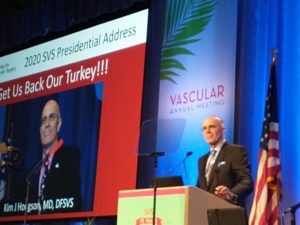
The Society for Vascular Surgery (SVS), in partnership with the American College of Surgeons (ACS), today (Thursday, Aug. 19) announced the future launch of a program to verify quality on the part of facilities that offer vascular care.
SVS Past President Kim Hodgson, MD, announced the Vascular Center Verification and Quality Improvement Program (VCV&QIP) during his Presidential Address at the Vascular Annual Meeting (VAM) in San Diego, California.
The Society’s aim in developing the verification process and program is to indicate to patients that program reviewers investigated and verified a particular institution’s quality improvement process and that it follows high standards and protocols. The verification assures patients that the centers provide high-quality patient care conducive to excellent patient care.
It is difficult for both governmental and non-governmental agencies, including third-party payers, to determine quality and appropriateness, said SVS leaders. As result of these substantial changes, SVS opted to define quality and appropriateness as value for the vascular specialty. The involvement of vascular experts in defining quality and appropriateness has been pivotal in building a quality infrastructure to support members throughout the ever-changing healthcare landscape.
The SVS/ACS VCV&QIP’s mission is to drive quality and value by guiding the vascular center to leverage the infrastructure necessary to perform various vascular procedures in an environment that is safe and conducive to excellent patient outcomes and to be a leader in vascular quality improvement. At its core, VCV&QIP follows six National Quality Strategies to align organizational functions to drive improvement based on the aims and priorities of the Agency for Healthcare Research and Quality (AHRQ), part of the U.S. Department of Health and Human Services. The areas are:
- Measurement and feedback with required registry participation
- Certification, accreditation and regulation with required facility regulation
- Consumer incentives and benefit designs with thorough discussion of treatment options and consent
- Health information technology, working with outside software for continuation of care
- Innovation and diffusion with research
- Workforce development with the capability of resident training
As with all ACS Quality Improvement programs, the VCV&QIP began with the development of the program’s “standards,” factors felt to be critical to the success of a program and against which a program is evaluated. Once the Standards were formulated, Hodgson and Anton Sidawy, MD, identified potential pilot sites, looking for both inpatient and outpatient verification levels, to apply the Standards to real world practices and fine tune them if needed.
Surgeons visited the first pilot site, the Albany Medical Center in Albany, New York, in April.
“The verification of inpatient and outpatient vascular centers is an important step in recognition of our specialized and distinct service to our patients and to our health care systems,” said R. Clement Darling III, MD, of the Albany Medical Center and a former SVS president. “The verification process was valuable to help us to understand what we need to provide the best longitudinal vascular care for our patients and will provide a roadmap to help institutions and payers understand the infrastructure needed to establish and maintain a comprehensive vascular service.”
In addition, verification, “will demonstrate to patients and providers that we are following standards and established protocols that have been peer-reviewed for their benefit by specialty trained vascular specialists/surgeons. I thought the process was comprehensive, fair, educational and a true benefit to our patients and our specialty of vascular surgery,” said Darling.
VCV&QIP requires institutions to examine and validate processes that should lead to the following: external credibility, improvement in quality, enhanced organization learning, high staff effectiveness and decreased liability cost and mitigating risk of adverse events.
Regarding his experience as a pilot site, William Shutze, MD, from the Baylor Scott & White Heart Hospital in Plano, Texas, said, “In preparation for the SVS/ACS vascular center verification site visit we underwent a comprehensive self-examination that identified our strengths, weaknesses and opportunities for quality improvement.”
“We were then able to leverage the motivation of all of the stakeholders in our facility, strongly desiring the recognition this verification brings, to endorse, support and enact the necessary measures to achieve designation as a verification center but more importantly, to elevate the quality of care our patients receive. This was only accomplished because we applied to be verified under this novel program. On behalf of myself and my colleagues at The Heart Hospital Plano (Texas), I encourage everyone to apply for verification.”
The Michigan Vascular Center participated as the first office-based lab (OBL) in the pilot phase. “The Michigan Vascular Center opened its first OBL in 2005 and opened a second in 2013,” said Robert Molnar, MD, adding that the centers have been accredited by the Accreditation Association for Ambulatory Health Care (AAAHC) for more than eight years.
“Our focus was always on providing care that was equivalent and even superior to that provided in the hospital setting. We felt that accreditation was important to signify our level of commitment to quality and best practice standards. When the SVS/ACS announced a vascular-specific verification program for OBLs, we wanted to participate and have our program evaluated to ensure we were providing the best possible care with the highest quality. The process allowed us to analyze what we had established and provided a process to reaffirm our commitment to quality and our patients.”
In the coming months, SVS and ACS will finalize the standards and infrastructure to provide vascular facilities with easy access to resources to guide them in applying for verification.












